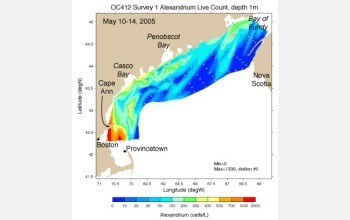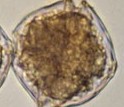News Release 05-094
Wind, Currents and Dormant Algae Cysts May Have Created "Perfect" Red-Tide Conditions
Automated sampling and ship-to-shore communication will aid response

A massive red tide is occurring off the New England coast.
June 3, 2005
This material is available primarily for archival purposes. Telephone numbers or other contact information may be out of date; please see current contact information at media contacts.
With shellfish beds from Maine to Cape Cod closed from the largest outbreak of red tide in 12 years in Massachusetts Bay, scientists are studying the algae that causes these "red tides" and providing information to coastal managers using new molecular techniques and oceanographic models.
"The nor'easter in early May off the New England coast was the 'perfect storm' in terms of Massachusetts Bay red tide outbreaks," said Woods Hole Oceanographic Institution (WHOI) biologist Don Anderson, who has studied red tides and other harmful algal blooms. "All the conditions were right for a major outbreak of Alexandrium fundyense, the predominant red tide species in this region. We've seen patches of red tide at the entrance to Massachusetts Bay on other occasions. This time, unusual winds and currents brought it directly into the bay."
Anderson and institute scientist, Dennis McGillicuddy, headed a long-planned research cruise in mid-May in Massachusetts Bay as a project for the Woods Hole Center for Oceans and Human Health (COHH). Center scientists conduct oceanographic, biological and environmental health research on problems like red tides, harmful algal blooms and other organisms in coastal waters that cause human illness and death. The May cruise was the first in a five-year study of harmful algal blooms.
Scientists aboard the ship collected samples at 160 stations along a series of transects from Massachusetts Bay north to the Bay of Fundy, taking samples at different water depths. Samples were then analyzed in the ship's laboratory. Using a novel method called a sandwich hybridization assay, researchers identified the alga Alexandrium fundyense, confirming it was indeed present in the bay and in waters to the immediate north.
McGillicuddy fed the biological observations and information about ocean conditions into a computer to create a model of the outbreak. He was able to map the extent of the red tide bloom, continually updating the model as new data were received.
"The current bloom is big, much larger in fact than the last outbreak 12 years ago, and much more widespread," said Anderson. "This is an unusual event."
The reasons why are unclear. Anderson and McGillicuddy say the current outbreak could reflect a number of converging factors, including the "perfect storm" idea in which conditions were right to introduce the red tide into Massachusetts Bay from the north.
The scientists also say there may be more dormant Alexandrium "cysts" in Gulf of Maine sediments than in the past, a result of a major red tide bloom last fall. Cysts remain dormant in sediments until conditions are favorable for germination and growth, leading to a bloom in subsequent years.
Another possibility is more freshwater is entering the Gulf of Maine this year than for a decade, a result of heavy rainfall this spring and heavy snowfall last winter. Increased freshwater provides the right conditions for extensive Alexandrium growth .
The WHOI center is one of four funded by the National Science Foundation (NSF) and the National Institute of Environmental Health Sciences (NIEHS). Scientists from WHOI, the Marine Biological Laboratory in Woods Hole, and the Massachusetts Institute of Technology formed the center in 2003.
"The appearance of this red tide is a clear demonstration of the timeliness of these centers," said David Garrison, program director in NSF's division of ocean sciences, which funds the centers. "With more frequent red tides in recent years, we need to find out why this increase is happening. The work of scientists at the Woods Hole center is a big step toward that goal."
Anderson says the ability to respond rapidly to such outbreaks, to collect and share data quickly with state agencies and local officials, is the wave of the future. "This project is a great example of how new technologies we're developing can help us work together to meet a societal need."
He expects to see automated instruments on buoys at sea in the future, collecting information and relaying it ashore where it can then be used to make forecasts - a technological step forward in red tide research. For example, the sandwich hybridization technique that scientists used aboard ship can be run in automated fashion inside moored instruments in observatory arrays, providing early warning of red tide cells and toxins.
-NSF-
-
The red-tide alga Alexandrium fundyense has closed shellfish beds in New England.
Credit and Larger Version
Media Contacts
Cheryl Dybas, NSF, (703) 292-7734, email: cdybas@nsf.gov
Shelley Dawicki, WHOI, (508) 289-2270, email: sdawicki@whoi.edu
The U.S. National Science Foundation propels the nation forward by advancing fundamental research in all fields of science and engineering. NSF supports research and people by providing facilities, instruments and funding to support their ingenuity and sustain the U.S. as a global leader in research and innovation. With a fiscal year 2023 budget of $9.5 billion, NSF funds reach all 50 states through grants to nearly 2,000 colleges, universities and institutions. Each year, NSF receives more than 40,000 competitive proposals and makes about 11,000 new awards. Those awards include support for cooperative research with industry, Arctic and Antarctic research and operations, and U.S. participation in international scientific efforts.
Connect with us online
NSF website: nsf.gov
NSF News: nsf.gov/news
For News Media: nsf.gov/news/newsroom
Statistics: nsf.gov/statistics/
Awards database: nsf.gov/awardsearch/
Follow us on social
Twitter: twitter.com/NSF
Facebook: facebook.com/US.NSF
Instagram: instagram.com/nsfgov



